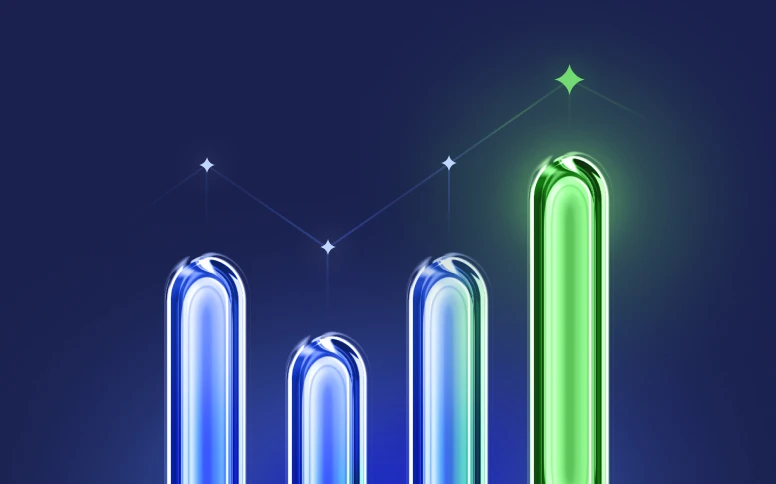45 Essential Sales Statistics to Maximize Profits in 2025
I’ve investigated the numbers backing up sales in 2025, and what I’ve discovered is that customers are more informed than ever before, that persistence still matters, and that digital fluency and AI tools help companies reach unprecedented growth levels.
After extensive research, I’ve collected the most important sales facts and statistics for 2025, so you can get a fresh perspective on your entire sales funnel.
Sales Prospecting Stats
First, sales reps engage in prospecting. Prospects of today are influenced by the ease of internet access, which makes them well-informed, and which changes how salespeople should start their initial conversation.
Prospecting statistics confirm that persistence, digital proficiency, and, most importantly, quality research data are now key to sales success.
1. 96% of prospects research before speaking to a rep
96% of prospects have done their own research before ever speaking to a salesperson. Your sales team should shift from educating about the product to conveying a personalized value and making human contact.
2. 71% of prospects prefer solo research
71% of prospects do their research independently instead of talking to a friend or a colleague. This tendency towards self-service shows that sales enablement content should be a high priority for your business.
3. 42% of salespeople cite prospecting as the most difficult part
Prospecting is not easy. 42% of salespeople speak of prospecting as the hardest portion of the sales process, even ahead of closure. Better training and more effective tools can help to alleviate this.
4. Sales reps spend 40% of time looking for new prospects
Sales reps often devote 40% of their time to simply finding potential clients or customers to call. This is a massive time spend dedicated to non-selling activities, and a major cut to sales productivity.
5. 76% of top performing sales reps research before cold calling
Preparation is what separates an average rep from an elite seller. Around 76% of top sales performers take their research seriously before dialing prospects. Pre-call strategy planning is paramount.
6. Connecting calls are best made between 4 and 5 p.m.
People are more willing to make a call when their workday is nearly over. The slot between 4 and 5 p.m. shows the most promise as the studies tell us that this is when reps are likely to reach prospects.
7. 57% of C-level buyers favor phone contact
57% of C-level buyers want to be contacted by phone, not emails or social media. This is one of the most valuable sales facts as it indicates that for high-value B2B prospects, the phone call remains the top strategy.
8. 82% of buyers are open to meeting proactive sellers
82% of buyers are open to meetings with those reps who proactively reach out. The chance of a successful meeting increases if the seller is able to offer personalized and relevant solutions.
9. High-growth organizations average 16 touch points per prospect
High-growth organizations specializing in sales average 16 touches per prospect within a two- to four- week span. The number of touch points is a key benchmark metric for developing an effective sales cadence.
Need help in planning out your next full touchpoint sequence? Check out our comprehensive guide on how to follow up with leads.
10. 78% of social sellers outperform their peers
Social selling is a proven strategy by now. 78% of salespeople who put their efforts into social selling achieve better results compared to colleagues who do not use social media.
11. Social sellers are 51% more likely to hit quota
Social selling proves to have a real impact on sales productivity statistics, with 51% of reps being more likely to reach their set sales quota.
Sales Follow Up Stats
A lost sale does not come from a bad pitch, but from simply failing to follow up, and failing to do so consistently.
Sales follow up statistics prove once again that persistence can drive your conversion rates and the lack of it, bury them.
12. Just 2% of sales are made on the first contact
The reality of sales: only 2% are made on the first contact. This fact can change the way you and your team look at your sales process and focus you on the long-term.
13. 44% of salespeople make just one follow-up before giving up
Most revenue-generating opportunities are lost to impatience. 44% of salespeople attempt a follow-up only once, before giving up completely. This tells us why many reps fail to hit their sales quotas.
14. 80% of sales require 5 to 12 follow-up attempts
92% of salespeople stop following up after four or fewer attempts, but the data shows that 80% of successful sales require at least 5 to 12 calls or emails after the initial contact. This delta is the difference between an average and a top performer.
15. 60% of customers say no four times before yes
60% of customers reject an offer four times before eventually saying yes. Multiple, sequential no’s are part of the sales process that can even be seen as a powerful mental training technique for reps.
16. Leads are 9 times more likely to convert when contacted within five minutes
Speed matters to leads as they are nine times more likely to convert when contacted within five minutes of an initial inquiry. Web forms integrated with CRMs, automated alerts, and overall rapid response from the team are a necessity.
A five-minute race can be won faster with automation. Watch our video guide to learn how to streamline sales with automation rules in Flowlu.
17. Response rate is 450% higher when calling within one hour of inquiry
Leads receiving a follow-up phone call within an hour of submitting an inquiry have a 450% higher response rate than those who did not receive a call. Qualifying leads fast is something one shouldn’t overlook.
18. 35% to 50% of sales go to the vendor that responds first
Companies and sales teams that are first to respond to a lead are more likely to secure the sale.
19. First follow-up email increases reply rate by 50%
The first follow-up email can improve the overall reply rate of a campaign by an impressive 50%. Emails and phone calls are unalienable parts of the sales process.
20. Email + social follow-up achieves
The combination of emails and follow-ups via social media (like LinkedIn) can achieve a high reply rate of up to 11.87%. This suggests that joint use of all available channels is effective.
21. Text message follow-ups have a 112.6 higher conversion rate
Text message follow-ups receive a 112.6% higher conversion rate than other methods. Another indicator is that a modern, multi-channel approach is necessary for smarter selling.
B2B Sales Statistics
The B2B sales stats present a picture of a complex environment. It’s marked by long sales cycles, dozens of decision-makers, and a clear shift to self-service.
B2B buyers, now well-versed in modern tech, know more, demand more, and are ready to wait before buying-in.
22. Average B2B sales cycle length is 84 days
The average B2B sales cycle length is approximately 84 days (or 12 weeks). A favorable decision will likely be taken if follow-ups support it throughout.
23. 75% of B2B buyers are taking longer to make a decision
The buying journey is becoming longer. 75% of B2B buyers need more time to decide on a purchase now compared to 2023. Be prepared for this trend to continue.
24. Typical B2B decision involves 10+ people
Ten or more people are involved in a final B2B decision. For reps to build consensus, they need to navigate a sometimes tangled web of stakeholders.
25. 80% of B2B interactions are now digital
A staggering 80% of B2B sales interactions occur using digital channels. This prediction was made by Gartner in 2020; we see that it’s really happening with IBM and Microsoft adopting digital sales rooms and online engagement tools.
26. U.S. B2B digital revenue share will hit 56% in 2025
The digital revenue share for B2B companies in the US is forecasted to reach 56% in 2025. This online selling increase trend was spotted and investigated using data from 2022 to 2023.
27. In 2030 75% of B2B buyers will favor human sales interactions over AI
AI overimplementation in 2025 can actually harm B2B sales in the long term as 75% of buyers will choose sales journeys built around person-to-person engagement rather than AI-powered ones.
28. 80% of B2B sales are driven by referrals
80% of B2B sales are initiated from referrals. By building strong relationships with existing customers you pave the way for the future success of your business.
The best sales process doesn’t end at the close! Learn how to turn your customers into a steady source of high quality leads.
29. Data decay renders 25% of B2B data obsolete annually
Research by Dun & Bradstreet shows that contact data can decay at an alarming rate of 25% annually. One quarter of your data becomes obsolete within a single year. This makes regular database maintenance an imperative task.
Inside Sales Statistics
Inside sales is the most effective strategy to overcome challenges in the B2B industry.
This model focuses on fully remote, tech-driven selling that allows practitioners to achieve greater productivity and lower cost per sale.
30. Inside reps make up 40% of high-growth B2B teams
Inside sales reps now constitute around 40% of high-growth B2B teams. This is a 10% increase from 2017.
31. 70% to 80% of B2B decision makers prefer remote or digital interactions
As noted, 70% to 80% of B2B sales interactions are now done via remote or digital channels. Reps need to be proficient in virtual selling tools to stay competitive.
32. Inside sales cost 40% to 90% less than outside sales
It costs 40% to 90% less to close a lead through inside sales compared to traditional, outside sales. Adoption of remote methods proves to be a good way to cut inhouse costs for many companies.
Sales Productivity Statistics
The reason you’re reading this article about sales stats is to find opportunities for increasing your own productivity.
Technology is the single greatest enabler for this, as confirmed by numerous sales and marketing statistics.
33. Sales reps spend 64% of their time on non-selling tasks
Reps spend 64% of their time on non-selling tasks like administrative and service work, training, travelling, company meetings. 36% of their time is spent actually selling.
34. Average salesperson spends only two hours per day actively selling
The average salesperson spends two hours a day actively selling products or services of their business. This presents a massive opportunity for automation of administrative and service tasks.
Stop wasting precious time on admin. Discover how to use business process automation to boost your team’s active selling time.
35. 79% of sales executives cite improving rep productivity as a key to growth
79% of sales executives put an emphasis on improving the productivity of existing sales. Many think it’s a key factor for hitting new targets. Adopting tools that support productivity is a logical conclusion.
36. Only 16% of sales professionals met quota in 2024
16% of sales representatives met quotas in 2024. It can be seen as a drop from 28% in 2023, and a heavy fall from 53% in 2012. The performance gap can be closed with new strategies and modern work tools to drive revenue growth.
37. 28% cite lengthy process as reason prospects back out
A very human reason prospects forego the deal is the length of the sales process. According to Hubspot research, 28% of sales reps point to this issue. Streamlined company processes equal higher success rates.
38. 94% of businesses report a productivity rise after CRM implementation
94% of businesses report a sharp increase in sales productivity after implementing a CRM system. This high percentage stems from the fact that CRMs are made to simplify most aspects of sales work.
39. CRM implementation increases sales revenue by an average of 29%
Businesses that have CRMs see an increase of 29% in sales revenue. If the right CRM is chosen, revenue growth can reach higher percentages.
40. Automation tools reduce non-selling time by 66%
Automation tools and platforms with in-built automations help to reduce time spent on non-selling tasks by 66%. Automatically scheduled calls and sent follow-up emails provide more opportunities for salespeople to focus on selling.
41. 81% of sales leaders believe AI helps to reduce time on manual tasks
81% of sales leaders think that AI can help to reduce time spent on manual tasks. This could be as simple as entering data into a CRM or generating basic standardized reports.
Sales Closing Statistics
All the efforts in sales prospecting, follow-up, and productivity throughout, lead to closing the sale.
These sales closing statistics serve as the benchmark for success in the final stages of the sales process.
42. Average sales close rate is approximately 29%
The average sales close rate is 29% across most industries as measured by Hubspot in 2024. This low average shows how difficult it is to convert prospects into paying customers.
43. Average sales win rate is about 21%
The average sales win rate is slightly lower than close rate, sitting at about 21%. Understanding both sales facts can give you a realistic baseline for setting team goals and expectations.
44. 81% of sales reps say team selling helps close more deals
81% of sales reps state that team selling helps them close more deals. The collaborative aspect, especially in B2B sales, is a huge factor.
Team selling works because of effective collaboration. Build cohesive teams by reading our guide on workplace collaboration.
45. 72% of company revenue comes from existing customers
A major sales fact is that 72% of company revenue is generated thanks to existing customers. Only 28% comes from new customers. Post-sale follow-ups are more important than follow-ups in terms of revenue.
Sales Facts and Statistics: Key Takeaways
These insights from sales statistics provide greater understanding of what needs to be done to grow revenue.
Take these actions:
- Stay persistent: you may need five or more attempts to close a sale.
- Embrace speed: win leads by enforcing the first five minutes rule.
- Focus efforts: automate non-selling activities to free your team.
- Use mixed channels: executives liked to be called; medium management is comfortable with an email.
- Invest in the right tools: adopt solutions that make sales processes easier.
Want to sell better?
See how Flowlu’s CRM helps teams follow-up persistently, respond quickly, streamline with automations, and diversify outreach—book a demo today.
Preparation is vital and directly reflected in sales prospecting statistics.
96% of the modern prospect has already researched before speaking to a sales professional.
Sales agent stats confirm that 76% of top performing reps research before making a cold calling attempt.
Effective training should focus on quality research to help agents find the right approach, especially since they spend 40% of their time just trying to find potential clients via cold outreach.
B2B sales facts indicate that the average B2B sales cycle is around 84 days long. Furthermore, 75% of B2B buyers are taking longer to decide compared to the previous year.
Effective territory management is complex because typically 10 or more people are involved in the final purchase decision, making consensus building hard for companies.
Speed is essential. Lead follow up statistics show a lead is 9 times more likely to convert when contacted within five minutes of an initial inquiry.
Response rates are 450% higher when the initial follow-up call is made within one hour.
Utilizing CRMs and automation (a key part of modern technology) can help ensure rapid response times, whether by a rapid call or an automated initial email, as being first to respond often secures the sale for your company.
Flowlu CRM is designed to help your sales teams implement the best practices highlighted by sales process statistics.
It focuses on the key areas for success: persistence in follow-up via automated email and strategic calls; speed to market by enforcing the 'five-minute rule' for new leads with automated notifications; and productivity management by reducing non-selling time through automation of routine tasks and business processes, and by providing valuable performance reports.
With Flowlu, sales teams can continuously improve their overall sales performance.


















